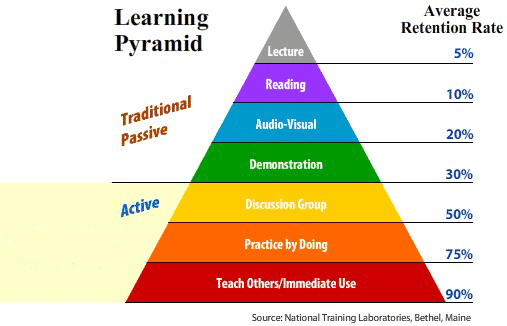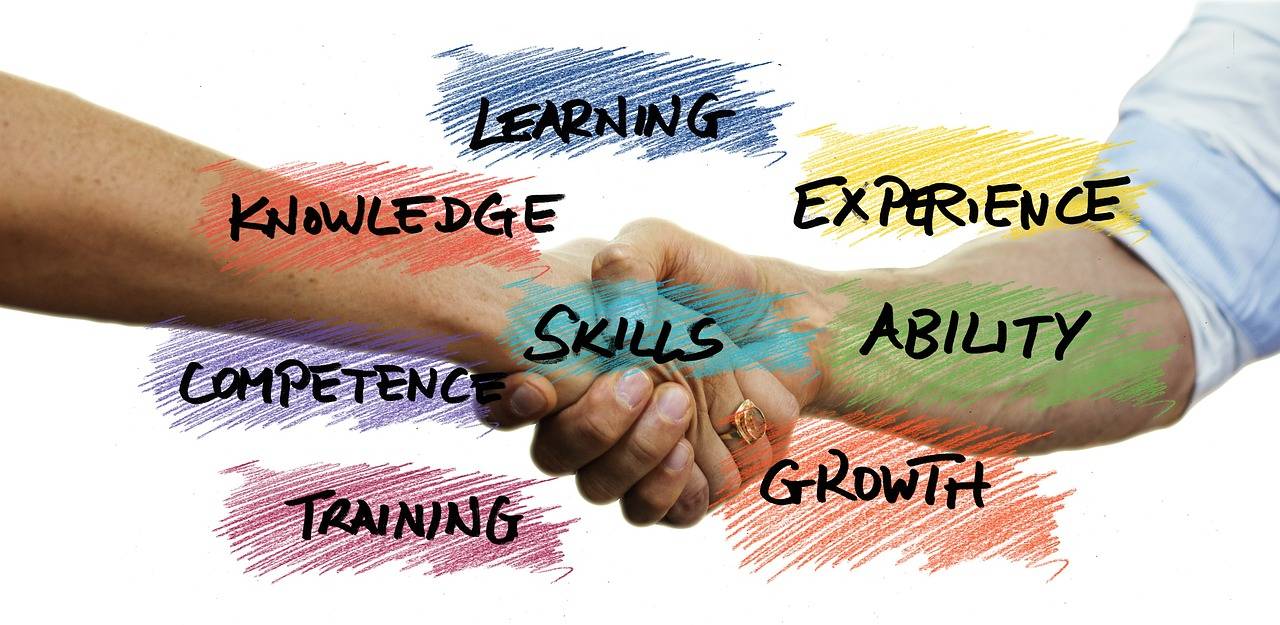
Top 3 Assumptions in Teaching Adults
- If I tell you once (lecture) you will remember it.
- If I show you once (demonstration), you will be able to do it.
- You have the same attitudes and background as I do, therefore you will be able to do it the way I want you to do it (discussion).
The Facts about Teaching and Learning
Passive Learning Techniques (when the instructor is active and the learners are passive) have the following retention rates:
- Lecture – 5%
- Reading – 10%
- Audio-visual – 20%
- Demonstration – 30%
Active Learning techniques have the following retention rates:
- Discussion Group – 50%
- Practice by Doing – 75%
- Immediate use/Teaching Others – 90%

From the National Training Laboratories in Bethel, Maine.
During a lecture, the lecturer is active and the learner is passive. The lecturer is the one doing the active learning, not the participant. Let’s look closer.
Instructor Active
- The instructor shares his or her expertise on a topic of learner interest.
- Often taught using YouTube instructional videos or in large group formats
- Often used for teaching single skills and answering “how to do” questions
Learner Active
- Instructor organizes learning experience into steps to competency and provides those steps to the learner.
- Learner active and often self paced using tools and directions provided by instructor.
- Often used to develop a set of skills that require not only knowledge, but problem solving and adaptability.
A Note to Active Adult Learners
It is the learning facilitator’s responsibility to provide you with the tools you need to learn what you want to learn.
Adult Learning Theory
Adult learning theory is the basis of CFAL. More and more these days that same theory is being applied to elementary and secondary education. This is mostly due to research that has shown very little learning occurs when listening to someone, while true learning occurs when you are actively engaged in the process of learning. It becomes the learning facilitator’s responsibility to provide you with the tools you need to learn what you want to learn.
Teacher’s Responsibility
I believe that the teacher, whether they be a boss, a trainer, a continuing education provider, an organizational leader, or any other kind of teacher has the responsibility at least to do no harm to his or her learner.
It hurts when you are trying with all your might to understand something that someone showed you, you just can’t do it, ask for help and get back “I already showed you how to do it!”. It clears the name of the teacher, after all she already told you and puts all the blame on you for not learning. Comments like those made from self-centered teachers do harm by diminishing self-worth and self-confidence of the learner. Mistakes are made down the line because the learner doesn’t ask again.
Learner-centered facilitators will usually respond to a person asking for help with “It’s OK, I’m glad you asked. Let’s see if there is another way we can work together to help you get this”. They understand that their responsibility is to provide experiences that help learner’s learn, so when learning does not occur, they look for learning solutions, not learner judgments. The second communication encourages questioning and self-responsibility to ask for what is needed.
Competence in Teaching and Learning
Competence is the ability, fitness or skill required to effectively perform a complex function. That function may be mental/emotional, as in leadership training or problem solving or physical as in becoming competent in handling an industrial machine or performing an effective physical treatment to another person.

Why is Active Learning so important?
Being competent involves aspects of thinking, feeling, and doing and cannot be attained through passive learning methods. Whether your programs are in the training department of a business, or academic classes, or professional education, the development of competence as the result of the educational experience is your main goal. The results should be a new, complex skilled performed not only in the experience, but carried over into the real life settings after the training.
Competent Performance
Competent performance involves the performance of many smaller aspects of thinking, feeling, and doing. When someone isn’t competent, they have failed to perform one of the smaller components or have failed to integrate the components in a meaningful way. It is up to a competent Certified Facilitator of Adult Learning to provide active learning experiences that enable participants to identify and perform specific tasks, and then help them integrate these tasks to perform the overall competency in a reliable and repeatable way. To do this requires the ability to perform a competency analysis, which is one of the first steps to becoming Certified as a Facilitator of Learning.


